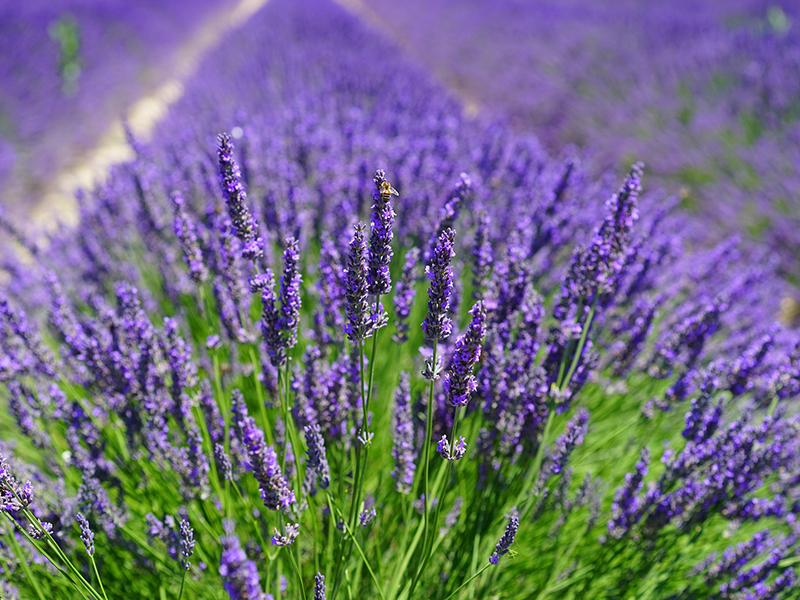- info@aromantique.co.uk
- 07419 777 451

The air richly infused with the fragrant scent of lavender, I walked into the greeting garden, beyond which stretched several neat linear rows of small purple bushes extended to the tree-lined distant edge of the adjoining field. On one side of the field, in beautiful contrast, a stunning array of sunflowers stood proudly as if watching over the purple sea. I had found lavender heaven; the view I gazed appeared to reflect a scene in a French-like painting, rustic, earthy, the ambiance ageless and romantic, sweetly scented and suspended in time.
Somerset Lavender is a small fifty-acre third-generation family-run farm, situated in the rural area of Faukland near Radstock. Once dairy farmers, Francis and Judith Green transformed the farm, converting from livestock to arable in 2004, focusing entirely on the growth and production of lavender, dedicating two five-acre fields solely for this purpose. Visitors are invited to walk amongst the lavender in the fields so they may fully experience and appreciate them (and observe the spectacle of numerous nectar collecting bees).
I arrived at the farm, armed with my camera, hoping to catch the last remnants of the floral blossom before the lavender flowering season ended. ‘Time and tide’ certainly ‘wait for no man’; being ‘too busy’ a passport to nowhere – the land of lost moments and illusive opportunities…… I skidded through the gate of opportunity just before it closed, the lavender blooms waning, their vibrant colours dwindling. But still the odour was rich, the scene beautiful and, as it transpired, there was an unexpected bonus…the flowering heads and stems of the first row of lavender bushes had just been harvested ready for distillation.
When I explained my reason for visiting the farm, to my delight, Francis kindly invited me into the distillery, which is housed within a large barn. The recently harvested first crop of lavender lay strewn loosely across the floor, left to dry slightly before being immersed into the distillation vat. Francis described the distillation process to me and demonstrated how the equipment worked.
He then picked up a pitchfork and began loading the lavender into a stainless steel vat and I was able to photograph the process in action. He filled, then pressed the fresh dried lavender flower heads and stalks down into the large steel vat, then filled it some more and did the same again, repeating the process until the vat was packed full. After this, he told me, water is added to the vat. The distillation apparatus was already in action with a vat that had been filled earlier.
A gas-fired burner heats the water in the vat for half an hour until it reaches boiling point and begins to convert to steam. The extreme heat, force and pressure of the steam ruptures the plant cells, bursting the cell walls and releasing essential oils and other volatile chemicals as the steam rises and pushes through the plant material. Reaching the top of the vat, the steam syphon’s through a pipe to another adjoining vat, which contains coiled tubing filled with cold water that rapidly cools the essential oil-infused steam, causing it to condense into water again. The condensed water is funnelled through a tube from the base of the second vat into a glass container.
As the water in the container cools further, the essential oil begins to separate from the water and floats to the surface, where it accumulates. This distillation process usually continues for two to two-and-a-half hours. The essential oils are gradually syphoned off. The cooled distilled water that remains contains non-volatile plant residue and other non-volatile water-soluble or ‘water loving’ chemical components extracted from the plant material. This water is either reused in the distillation vat and/or cooled and stored in sealed sterile bottles as lavender hydrosol or ‘perfumed water’ (this is also how witch hazel or rose water, among others, are produced).
Apparently, there are three types of essential distilled from the three species of lavender grown at the farm: English Lavender (Lavandula angustifolia), ‘French Lavender Stoechas’ and ‘Lavender Intermedia Hybrid’. Lavandula angustifolia ‘Maillette’, one type of essential oil sold at the farm, is produced from a seedless cultivar (propagated from softwood cuttings) grown for its intense, sweet odour (attributed to its higher content of linalyl acetate).
With its fields of lavender edged with sunflowers, distillery, café and shop selling an array of lavender plants, farm produced essential oils and products, Somerset Lavender Farm is definitely worth a visit; even if just to take in the beautiful scent and ambiance of the fields full of lavender.
To learn more about essential oils:
Essential Oils for Mindfulness and Meditation
Essential Oils for the Whole Body
Essential Oils: Safe Use and Application